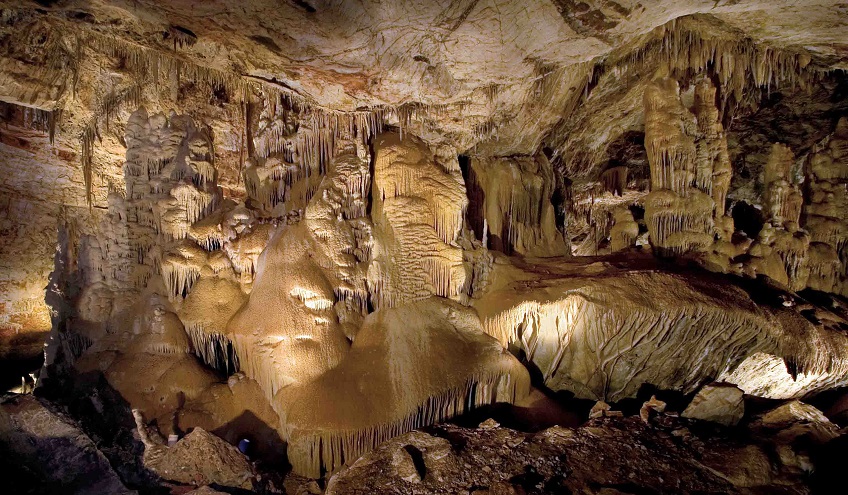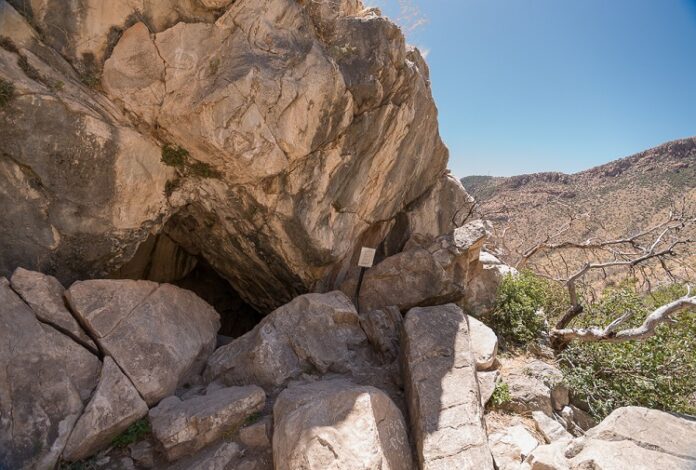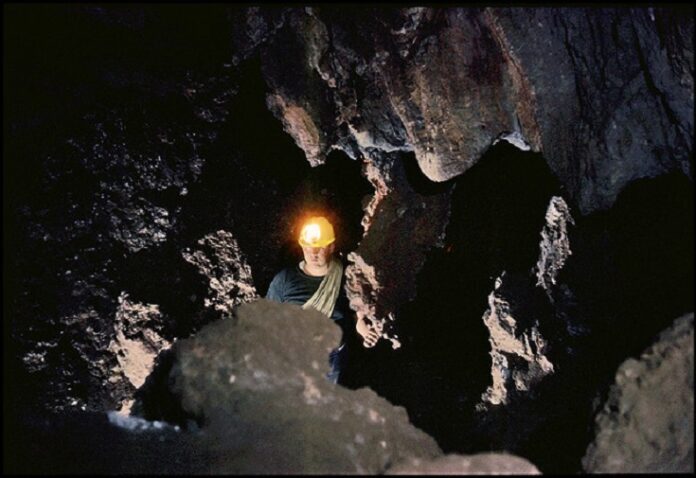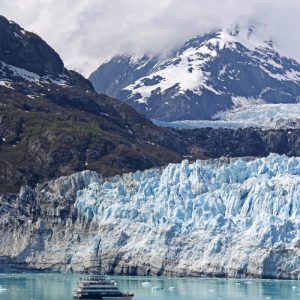![]()
 100vw, 696px” data-lazy-src=”https://acovalue.info/wp-content/uploads/2023/10/15-best-caves-to-explore-in-arizona-696×364-1.jpg” /><img decoding=)
Are you into spelunking? Are you at all curious about exploring caves? If you’re headed in the direction of the US state of Arizona, have we got the place for you. In fact, we have several places to check out some cool caves complete with unique formations and a multitude of miscellaneous minerals too. Get ready to take notes, readers, because here are the 15 best caves to explore in Arizona.
Contents
- 1. Kartchner Caverns State Park
- 2. Soldier Pass Cave
- 3. The Birthing Cave
- 4. The Subway Cave
- 5. Shaman’s Cave also known as Robbers’ Roost
- 6. Lava River Cave
- 7. Colossal Cave Mountain Park
- 8. The Grand Canyon Caverns
- 9. Peppersauce Cave
- 10. The Wave Cave
- 11. Onyx Cave
- 12. Wind Cave
- 13. Keyhole Cave
- 14. The Coronado Cave
- 15. The Cave of the Bells
15 Best Caves to Explore in Arizona
1. Kartchner Caverns State Park

This state park is located outside of Benson. This cave system was discovered by cave enthusiasts Gary Tenen and Randy Tufts in 1974. The limestone Kartchner Caverns are highlighted by the longest stalactite structure in the world, developing stalagmites, unique minerals, a large bat population, and numerous nooks and cavernous crannies to see.
Be the Gilligan of the spelunking set, and be sure to book and take the “three-hour tour.” You can visit even on the hottest day in summer because these caves are kept at a comfy 70 degrees Fahrenheit. Here you can see the different travertine rock formations up close and gain a truer understanding of the time required to form the fragile towers and spindles and geology in general. You can also go camping, go hiking, do some wildlife viewing, and rent a cabin if you don’t like tents. Visit the Discovery Center too. The entrance fee here is $7.00 per vehicle.
2. Soldier Pass Cave
 100vw, 696px” data-lazy-src=”https://acovalue.info/wp-content/uploads/2023/10/soldier-pass-cave-696×522-1.jpg” /><img decoding=)
Hikers who are cave-curious will enjoy the easily accessible Soldiers Pass Cave Spur Trail just three miles from downtown Sedona. It’s a less-than-three-mile out-and-back hiking trail often rife with pretty wildflowers, is family-friendly, and fine for hikers of all skill levels. The most popular activities here are hiking and wildlife viewing.
This cave not only provides summer visitors with cool shade from the Arizona heat but also allows them to enjoy watching the interior colors change as the sun changes position. The gated lot at Soldier Pass Trailhead No. 66 only has a dozen or so parking spots so get there early. Otherwise, you will end up parking on the street and adding almost another mile to your hike.
Check the signs too because you are not allowed to just park anywhere on the street. The trailhead has set hours. It’s open from 8:00 a.m. to 6:00 p.m. Interested in taking in the sunrise or sunset? Then park on the street.
3. The Birthing Cave
 100vw, 696px” data-lazy-src=”https://acovalue.info/wp-content/uploads/2023/10/birthing-cave-696×522-1.jpg” /><img decoding=)
While you’re in Sedona, check out the Birthing Cave too. There’s an easy, flat, wide, two-mile out-and-back hiking trail to this shallow cave nestled on the side of a small cliff. It has a large diamond-shaped opening overlooking the city’s red rocks.
Oddly, while this cave is supposedly quite popular and the cave can be busy with other hikers, the trail itself is rather uncrowded and peaceful, all things considered. Veteran visitors suggest parking off the road at the Long Canyon Trailhead and starting your hike there. Unlike the parking lots at Devil’s Bridge or Cathedral Rock, the parking lot at the trailhead is surprisingly small.
Be sure to watch for an obvious hollow in the face of the rock. That’s where you will discover the Birthing Cave. If you like wildflowers, visit between early March through May. Otherwise, the temperatures can be just as nice during September and October. The cave faces east so try to see the sunrise there.
4. The Subway Cave
 100vw, 696px” data-lazy-src=”https://acovalue.info/wp-content/uploads/2023/10/sedona-arizona-696×870-1.jpg” /><img decoding=)
The Boynton Canyon Trail will lead you to the once-hidden gem known as Subway Cave in Sedona. While this secret cave is no longer so secret, much of the trail and even the cave itself are still unmarked and easy to miss if you aren’t paying attention. If the parking lot at the Boynton Canyon Trailhead is full, park a short distance away on Boynton Pass Road. Keep track of how far you hike because the turnoff that leads to the cave is near the second mile.
It is not marked and is easy to miss. Veteran visitors can confirm that some locals and even other hikers sometimes throw branches across the turnoff in order to hide it. Ah, but while this trail is sometimes hard to follow and is often overgrown, the cave is incredible inside. Be sure to get a gander at the striking Native American ruins right on the ledge along the left side of the cave too.
5. Shaman’s Cave also known as Robbers’ Roost
 100vw, 696px” data-lazy-src=”https://acovalue.info/wp-content/uploads/2023/10/14-flickr-1-696×348-1.jpg” /><img decoding=)
Also known as the Hide Out Cave, you will find this cave just northwest of Sedona. Local legend has it that this cave was once a hideout for assorted bootleggers and bandits. It’s accessible from any of the town’s high vantage points.
In 1932 a movie titled Robbers’ Roost was filmed close to the city. No one has unarguably verified whether or not part of it was shot here at this popular off-the-beaten-path cave. It certainly provides visitors with exceptional panoramic views of the surrounding area and thus would make a great hideaway. The hiking trail to the renowned roost is less than one mile out and back but it is rocky and steep so watch your step if you choose to explore this cave.
6. Lava River Cave
 100vw, 696px” data-lazy-src=”https://acovalue.info/wp-content/uploads/2023/10/2-wiki-696×463-1.jpg” /><img decoding=)
Travel to Flagstaff to the well-known Coconino National Forest. For it is there you can explore the long lava tube known as the Lava River Cave. It was formed by a large volcanic eruption about 700,000 years ago.
If you want to cool off, the best time to visit is in the summer. The caves are, on average, only 40 degrees Fahrenheit and you might even spot a bit of ice. Even in the summer, you should take thick clothing, because the cave and its connected caverns can actually drop to under 30 degrees.
You’ll have to do your homework before entering though since it is a “self-guided trip.” Another reason to visit in the warmer months is that the roads can be shut down in the winter. In fact, in the winter the more athletic visitors can actually ski into this cave when there’s enough snow. So check on road conditions if you’re interested. Admission is free.
7. Colossal Cave Mountain Park
 100vw, 668px” data-lazy-src=”https://acovalue.info/wp-content/uploads/2023/10/1-2.jpg” /><img decoding=)
The colossal cave system called Colossal Cave is conveniently situated 22 miles out of Tucson. More specifically, it’s located in a beautiful, 2,400-acre mountain park. It includes some of the area’s best caves.
You can learn about the cave’s interesting geological composition, history, and legends by taking the popular half-mile guided tour. One of the most popular tours takes less than one hour.
Walking down almost 400 steps here will make you seem as if you’re on a journey to the center of the earth. The tours are offered daily and the price charged depends on your choice of tour. The classic cave tour is family-friendly and no extra equipment is required.
The most challenging is the three-and-a-half-mile tour is the most in-depth and rigorous. Be warned, you will get dirty, trekking through small passageways, pitch-black tunnels, and tight spaces. Schedule your visit at the right time and watch hundreds of bats fly from these caves after sunset. Admission is free.
8. The Grand Canyon Caverns
 100vw, 696px” data-lazy-src=”https://acovalue.info/wp-content/uploads/2023/10/the-grand-canyon-caverns-696×523-1.jpg” /><img decoding=)
You will find this cave in the Peach Springs area unsurprisingly close to the Grand Canyon. Formally discovered in 1927, this now-protected cavern system has limestone walls that are reported to be “geologically identical” to the cliffs of the famous canyon. It is the largest dry cavern in the world.
In order to reach this admittedly eerie cave system, you must ride an elevator 21 floors, between 200 and 300 feet. Upon arrival, you have a choice between four different walking tours of different difficulty levels. An advanced tour will take you deeper into less visited areas of the cavern system and involves equipment.
The beginner tour is family-friendly and fine for all interested parties. It’s just a comparatively short walk that focuses on the larger sections of the system. If you are visiting the Grand Canyon and have additional time, a visit to these caverns will add even more adventure to your vacation. Fees vary according to your tour choices.
9. Peppersauce Cave
 100vw, 696px” data-lazy-src=”https://acovalue.info/wp-content/uploads/2023/10/1-3-696×418-1.jpg” /><img decoding=)
Peppersauce Cave, less than 10 miles from Tuscon in Oracle, is actually a system of limestone caves. Specifically located in the Coronado National Forest, it can only be reached via dirt roads that are reportedly poorly maintained. While there is a roadside sign directing you to the official entrance, there are no tours offered.
Despite featuring its own lake, the cave system remains in a primitive state. There are no visitor facilities either. You must squeeze through a tight opening in order to get inside.
The rocks here are generally wet and slippery so along with the required headlamps (preferably on helmets), experts strongly recommend visitors wear non-slip shoes too. Knee and elbow pads aren’t a bad idea either. Do not visit if rain is in the forecast as the water levels here can rise dangerously. The “Big Room” and “The Rabbit Hole” are popular places if you prefer assistance in accessing parts of this system. Admission is free.
10. The Wave Cave
 100vw, 450px” data-lazy-src=”https://acovalue.info/wp-content/uploads/2023/10/7-pinterest-reddit.jpg” /><img decoding=)
Journey to Gold Canyon to visit the Wave Cave. It’s probably the only place in the state where you can go surfing in the desert. Here you must first hike through the striking Superstition Mountains to a distinctive rock formation that looks like a wave coming out of a cave.
The hike is three miles round trip and rated as difficult due in part to the 860+-foot elevation gain. The final climb to this cave is considered strenuous and you’ll have to use your hands. The good news is that the cave is big enough to fit a number of hikers seeking relief from the infamous Arizona Sun.
Watch your step on your hike down because there’s a lot of loose gravel and the slope is somewhat steep as well. Do not attempt this pleasant albeit challenging trek on the hottest summer days. There is a $15.00 fee for parking.
11. Onyx Cave
 100vw, 674px” data-lazy-src=”https://acovalue.info/wp-content/uploads/2023/10/8-flickr.jpg” /><img decoding=)
Head for the rugged Santa Rita Mountains and the Coronado National Forest to explore the limestone maze of rooms and passageways known as Onyx Cave. Various geological pressures slowly cracked the aged limestone here. Water rushed through the cracks, the cracks grew larger, and eventually resulted in this well-known cave.
The cave was declared an official National Natural Landmark in 1974 and fenced off to keep it safe from damage and vandalism. Today, after restorative efforts, it is back to its original condition. While it is reportedly challenging to reach, it is also possible to have the whole place all to yourself for several hours.
Now owned by Escabrosa Grotto, Inc., all visitors must make reservations for a visit and gate key at least two weeks ahead of time. Once you’ve done that, you are all set to explore this cave system unencumbered by too many other visitors.
12. Wind Cave
 100vw, 674px” data-lazy-src=”https://acovalue.info/wp-content/uploads/2023/10/9-1.jpg” /><img decoding=)
One of the most popular hikes in Mesa is the trek to Wind Cave. It is three miles in total and includes an elevation gain of almost 800 feet. It should take you no more than a total of two hours.
The terrain here is fairly dominated by palo verde and desert cacti. In fact, it is often comparatively dense with Saguaros. If you hike up there early enough, you’ll be shaded from the sun the entire time.
Once you arrive at the comparatively shallow cave you will be rewarded with not only cooling shade but a memorable view too. The view of downtown Phoenix and other sections of the valley will surprise you. Don’t be in a rush to hike back down though as the trail’s totally exposed to the Arizona sun in the afternoon.
Parking is limited so get here early. The trailhead is well-marked and has restrooms too. You must buy a day pass for $7.00.
13. Keyhole Cave
 100vw, 450px” data-lazy-src=”https://acovalue.info/wp-content/uploads/2023/10/12-deviantart.jpg” /><img decoding=)
Another required Sedona stop for spelunkers and hikers curious about caves is the Keyhole Cave. You’ll take the moderately-trafficked Sugarloaf Trail to reach this cave. It’s a 2+-mile out-and-back hiking trail that’s open year-round.
You can even bring your dog if you keep him on a leash. Be sure to get here early though because the parking is limited and street parking is not allowed. From the Sugarloaf Trailhead, you’ll actually be able to see the cave in the distance.
See that huge gaping opening in the mountainside? That’s it! The best time to visit this cave is whenever there is no snow. Otherwise, the hike will not only be steep but will be quite slick too.
Don’t try this hike immediately after a good rainfall either for similar reasons. Remember that much of this hike is in a wash. So if there’s a good chance of rain, just stay home and don’t risk being caught in a flash flood.
14. The Coronado Cave

This cave in Hereford close to the Arizona-Mexico border is actually a subject of much debate amongst hardcore spelunkers. Some argue that it is a large cave with a number of rooms, and others think it is a comparatively small cave. Admission is free but you need to get a free permit at the official visitor center.
The fact is that the cave is as wide as 70 feet in some sections and almost 600 feet long. Depending on your size, you may have to do some crawling in order to get from one section to another. The hike here can be a bit challenging for some since it includes a 500-foot ascent within the first half-mile.
Veteran visitors claim this is the best cave in the entire state for spelunking due in part to its reputed “mysterious aura.” While it is an official part of the popular Coronado National Memorial Park, no state-run guided tours are offered. Admission is free.
15. The Cave of the Bells

This cave, nestled in Coronado National Forest’s striking Sawmill Canyon in Patagonia, provides perhaps people with the state’s most fun spelunking experience. You have to hike for four miles up a dirt road to reach this place. If you’re not feeling athletic, drive a high-clearance or 4WD there.
Believe it or not, the inside of the cave is actually warm. There’s also a permanent lake not too far from the cave entrance. This underground lake is roughly 263 feet below the surface. The official lake tunnel entry leads to this well-known underground lake.
Strangely, the deeper you hike, the warmer the temperature of both the air and the lake. Experts say this happens because there is actually some heat source under the surface of the lake. Be aware that, just like Onyx Cave, the entrance to this cave is gated and locked.
Due to this cave’s extremely delicate environment, travelers must contact the Coronado National Forest Supervisor’s office, make reservations, and leave a deposit of $100.00 to get the keys. When the gate keys are returned, the deposit is refunded.



